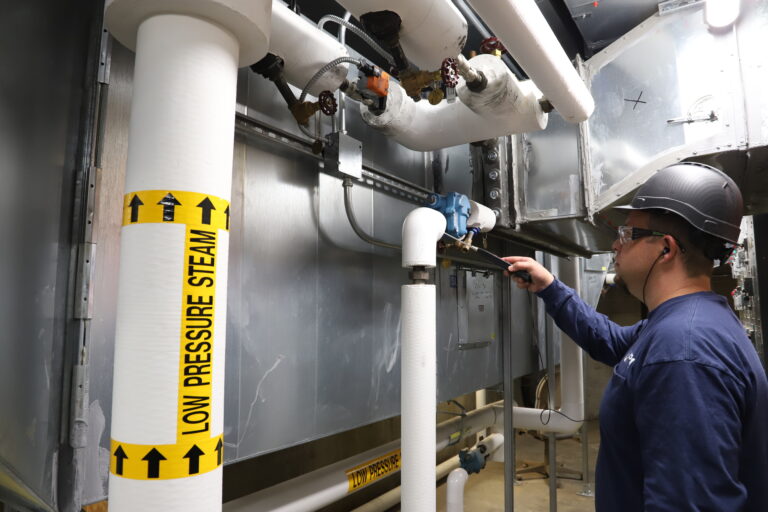September 2017 — Although a security system should begin at the entrance to the building, elevators must also be considered in a complete building security scheme. In addition to being equipped to provide safe and reliable elevator operation, elevators also can be integrated with other building security and emergency systems such as monitoring systems, access control systems, communications systems, fire emergency systems, and emergency power systems.
Monitoring Systems
Monitoring systems are generally used to provide safety to the occupants of an elevator cab. These systems may be as simple as a mirror mounted inside the cab that lets passengers see the interior before entering. They may be as complex as a two-way intercom system and video surveillance along with microphones in each car that connect to building security. Most systems today use closed-circuit television for visual as well as audio surveillance.
Access Control Systems
Access control systems allow elevator operation from the main floor of a building to upper floors to be controlled automatically by restricting passengers, floors, and times. During designated hours, only authorized people can operate such elevators to reach designated floors.
A common access control system uses magnetically coded cards. Each authorized person receives a card that must be inserted into a reader in the elevator control panel for service to specified floors during periods of restricted access. The card is coded for access only to a specified floor or floors. Card readers in elevators have magnetic sensors that automatically permit elevator operation according to the coding on the card. A master console in the building office or some other secured location permits the system to be turned on or off and limits access to selected floors by manual means or clock control.
If a passenger tries to access a restricted floor without the correct card, the buttons will not operate, and the elevator remains stationary. In most buildings, the first-floor button is not coded; by law, this floor must be available to anyone.
Communications Systems
A variety of systems can provide quick communications to passengers who find themselves in a nonworking elevator. Some of these systems provide telephones in the car that directly link the elevator to the elevator maintenance company. Other systems operate automatically through a direct modem link to the maintenance company.
Fire Emergency Systems
Fires seldom start in well-maintained modern elevators. Unfortunately, however, elevators are vulnerable to fire originating elsewhere in a building. Elevator codes require elevator hoistways and doors to resist fire and heat long enough for people to evacuate the building. Nevertheless, elevators are not designed to operate under conditions of extreme heat, fire, explosion, or water. Elevators must never be used to evacuate tenants from buildings, because the elevator hoistway can act as a chimney for smoke; anyone in the elevator would be at risk for smoke inhalation.
Special Emergency Service
To safely evacuate passengers when a fire occurs, elevators have control circuitry for special emergency service in compliance with the ASME Safety Code for Elevators (A17.1). Once initiated by a key switch or smoke detector, the elevators automatically travel nonstop to a previously designated floor. This is usually an exit floor, where passengers may safely leave the building. However, if the fire alarm is initiated from the designated floor, the elevators would go to a predetermined secondary landing.
Special emergency service can be incorporated into control systems for new elevators or added to existing installations. Special emergency service usually has two phases of operation.
Phase 1, initiated by a lobby key switch or fire sensors, returns the elevators nonstop to the designated floor and parks them there with doors open until the emergency is over. This prevents occupied elevators from stopping at fire-involved floors.
Phase 2, initiated by a special key switch in the car’s operating panel, makes elevators available for emergency use by firefighters or other qualified personnel.
As required by the elevator safety code provisions cited above, Phase 1 of special emergency service goes into operation manually by key switch or automatically by signals from smoke devices. When this operation begins, car and hall buttons and door reopening devices for power-operated doors no longer work. An elevator moving up reverses direction without opening its doors and returns to the designated floor, without stopping for car or hall calls. Elevators stopped at upper floors close their doors and return to the designated floor, also without stopping for car or hall calls. All cars park at the designated floor with their doors open to provide ready access for emergency personnel. Elevators are restored to normal operation by the lobby key switch, which has a third position to override the devices that activated the special emergency service.
When all of the elevators have returned to the designated floor and discharged their passengers, the cars become available for firefighters. A firefighter uses a special key to operate a switch in or adjacent to the car operating panel. Property management and maintenance personnel should check with their elevator service company to ensure that the firefighter’s recall will override any access-control devices, so that firefighters will have access to all floors during an emergency operation.
Emergency Power Systems
As a safeguard for elevator passengers during an electric power failure, many buildings have emergency power systems that supply electricity to lower the elevators to the designated floor. Other systems may only provide energy to operate lights, fans, and intercoms. Most hydraulic elevators have a battery-operated lowering option.
The minimum recommended emergency power supply for elevators is the capacity to move one elevator at a time at normal speed. The elevators must be able to handle a capacity load at normal speed. In this design, the power supply is connected so that only one elevator may be operated at a time. The system is manually controlled with a selector switch. After passengers are released from the elevators, one car remains in service until full power is restored.
Elevator Emergencies
Elevator equipment protects passengers by preventing car movement if conditions are not satisfactory and by stopping the car if unsafe conditions occur while it is moving. On rare occasions, passengers may have to be helped out of elevators stopped between floors because of power failure, application of the car safety device, equipment malfunction, fire, or other disaster. Unqualified personnel who attempt to circumvent elevator safety devices can be seriously injured or killed. Only qualified emergency response personnel should attempt to remove passengers from a disabled elevator car.
If an elevator stops between floors with passengers in the car, proceed as follows:
Immediately summon a qualified elevator professional and advise of the shutdown. Elevator professionals know the equipment and the hazards involved in removing passengers from a stalled car. They can discover the cause of the shutdown and decide whether or not the trouble can be remedied quickly.
Use the intercom system to the elevator to reassure passengers that help is on the way. Tell them that they are safe as long as they do not panic or try to open the doors without specific directions from qualified personnel.
In many urban areas, the fire department is dispatched to handle evacuation of people from a stuck cab.
If there is no direct communication system to the elevator car, locate the elevator in the hoistway and reassure the passengers through the nearest hoistway door.
If the elevator is stalled because of a malfunction that can be corrected quickly, passengers should be advised. In these cases, no further emergency measures are necessary. Once the malfunction is remedied, the car will proceed normally. If passengers were instructed to put the emergency stop switch in the stop position, instruct them to restore it to the normal operating position when the trouble is repaired.
Modern automatic elevators usually have hoistway door locks that release automatically when the car is at or within a few inches of the floor level. If the elevator is within this range, the elevator professional can open the hoistway door by hand from the landing side by merely pulling on the doors.
If power is available and the car is at a landing, the doors may be reopened if the landing hall button is pushed or an elevator passenger presses the door-open button in the operating panel. The passenger can also open the car and hoistway door manually, if the elevator is within a few inches of the floor.




